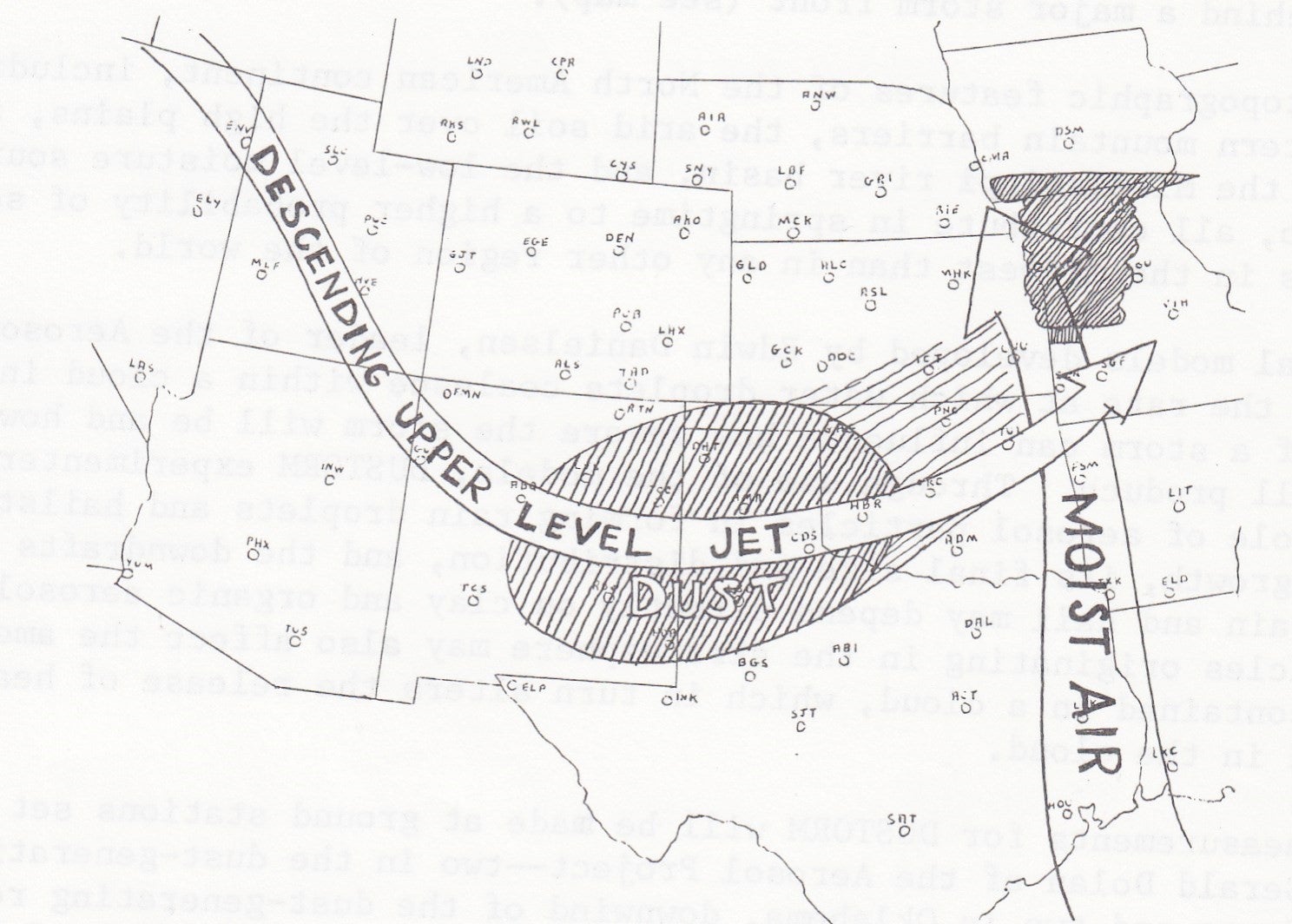DUSTORM
Project Dustorm
Project DUSTORM, conducted through the Atmospheric Aerosol Project of NCAR, investigated the influences of both large-scale cyclogenesis and microphysical processes caused by the influences of atmospheric aerosols on large-scale, organized outbreaks of severe weather (thunderstorms, hailstorms, and tornadoes) which occur in the Midwestern and Central United States in the Spring. The goal was to identify the large-scale phenomena which both generate the convective stability and trigger its release, and to determine special techniques for predicting the phenomena with sufficient lead-time to direct a combined ground-based and aircraft experiment. These concepts involved a complex chain of events initiated by the coupling of a strong surface heat source and an upper-level momentum source. Solar heating of the soil in the arid southwest destabilizes the air, producing an adiabatic mixing layer to depths of 3-5 km. This destabilization increases the available potential energy in the troposphere and the amplification rate of large-scale wave perturbations. An upper-level jet, propagating eastward across the Gulf of Alaska, supplies the momentum for the large-scale cyclogenesis.
Four aircraft and a multiple special surface stations were utilized in collecting data for this project. The experiment was centered around the dust storms that occurred in Northern Texas and Southern Oklahoma during April, 1975.
SCIENTIFIC OBJECTIVES
The major objectives were to determine whether:
- The large airborne soil particles (larger than 10 microns) enter the severe convective storms and trigger coalescent growth upon being wetted.
- The small particles, particularly the clay and organic matter, control drop freezing and therefore production of hail.
- The stratospheric aerosols, when mixed into the growing cumulus, control the supersaturation and release latent heat by the formation of the cloud droplets
Other Objectives included: 1) Determine the size, number distribution, and vertical flux of dust for different wind speeds and soil conditions; 2) Test the hypothesis that wind erosion causes breaking up of soil aggregates; 3) Measure the transport of dust from soil erosion areas; 4) Determine the nucleating capability of vegetative matter; 5) Determine the chemical fractionation of dust as it is generated and transported; 6) Study the hydrogen/deuterium ratio in hailstones from severe storms; 7) Study the structure of dust layers in the dry air being mixed into the severe storms, and study suspension of dust when the heating is cut off from the ground; and 8) Determine the characteristics of aerosol particle formation in stratospheric air as it moves into the troposphere.
OBSERVATIONS
Field measurements of dust size, number distribution, and vertical flux under different wind speeds and soil conditions were made at ground stations in the dust generating regions of northern Texas and two in Oklahoma (downwind of the dust generating regions). One of the field sites included a 500 m tower operated by NOAA’s National Severe Storms Laboratory (NSSL), sonic anemometer measurements by the University of Oklahoma (OU), a vertically pointing Lidar by NCAR’s Field Observing Facility (FOF), and rain sampling/size measurements by the Illinois State Water Survey (ISWS). Members of NCAR’s National Hail Research Experiment (NHRE) made special field collections of hail samples using a mobile unit and collected samples taken by local citizens in the hailswath area.
Four aircrafts were flown collecting a number of aerosol parameters including physical measurements on impactors and filters. The aircraft included: (1) the NCAR Sabreliner jet, which followed the dust as it was advected eastward; (2) the NCAR L-188 Electra, which monitored the stratospheric aerosols transported into the mid-troposphere during tropopause folding; (3) the NCAR Queen Air, which made measurements in the dust-generation region; and (4) the University of Wyoming (UW) Queen Air which sampled the air outside the storm clouds and at storm base.
 |
DATA
| Aircraft | NCAR Sabreliner; NCAR L-188 Electra; NCAR Queen Air; and UW Queen Air |
| Lidar | NCAR vertically pointing lidar |
| Photography | Hail stone collection by NCAR |
| Surface | Mobile NHRE Hail measurements |
| Surface | Special surface station observations from Plainview, TX; Plains, TX; Woodward, OK; Oklahoma City, OK; Big Springs, TX; Urbana, IL; and St. Louis, MO. |
Further information and details on Dustorm-75 can be found at: Fogle, Benson, 1975: Project Duststorm ’75 Operations Plan. National Center for Atmospheric Research. 7 March 1975. 22 pp.